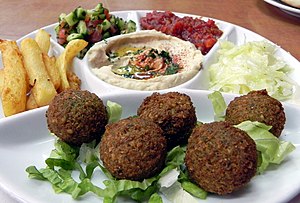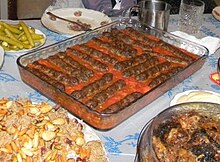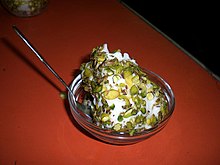| This article needs additional citations for verification. Please help improve this article by adding citations to reliable sources. Unsourced material may be challenged and removed. Find sources: "Syrian cuisine" – news · newspapers · books · scholar · JSTOR (May 2015) (Learn how and when to remove this message) |

| Part of a series on the |
| Culture of Syria |
|---|
 |
| History |
| People |
| Languages |
| Cuisine |
| Religion |
| Art |
| Literature |
| Music |
| Media |
| Sport |
| Monuments |
| Symbols |
Syrian cuisine is a Middle Eastern cuisine that traces back to ancient civilizations, influenced by Greek, Armenian, and Persian cultures. Syrian specialties makes use of eggplant, zucchini, garlic, meat (mostly from lamb and sheep), sesame seeds, rice, chickpeas, fava beans, lentils, steak, cabbage, cauliflower, vine leaves, pickled turnips, cucumbers, tomatoes, olive oil, lemon juice, mint, pistachios, honey and fruits.
Selections of appetizers known as mezze are customarily served along with Arabic bread before the Syrian meal's main course, which is followed by coffee, with sweet confections or fruits at will. Many recipes date from at least the 13th century.
Foods
Meze
| Name | Description |
|---|---|
| Baba ghanoush/ mtabbal (بابا غنوج) | eggplant (aubergine) mashed and mixed with seasonings |
| Baterish (باطرش) | mashed roasted eggplant |
| Falafel (فلافل) | a deep-fried ball or patty made from ground chickpeas, fava beans, or both |
| Fasolia bizzeit (فاصوليا بزيت) | green beans with olive oil, lemon and garlic |
| Fatteh (فتّة) | pieces of Arabic bread covered with other ingredients |
| Fattetil-makdus (فتّة المكدوس) | Fatteh with makdous and minced meat |
| Fatteh billahm (فتّة باللحم) | Fatteh with meat |
| Fatteh bissamn (فتّة بالسمن) | Fatteh made with beef or sheep tallow |
| Fatteh bizzayt (فتّة بالزيت) | Fatteh made with vegetable, corn, or olive oil |
| Fattet jaaj (فتّة دجاج) | Fatteh with chicken |
| Fattoush (فتوش) | salad made from several garden vegetables and toasted or fried pieces of pita bread |
| Halloumi cheese (جبنة حلومي) | usually sliced and grilled or fried |
| Harraa' esba'o (حراق اصبعو) | lentils with dough |
| Hummus (حمص) | a dip or spread made from cooked, mashed chickpeas, blended with tahini, olive oil, lemon juice, salt and garlic |
| Hummus billahm (حمص باللحم) | hummus with meat on top |
| Jez mez / jaz maz (جظ مظ) | eggs in tomato stew, Syrian shakshouka |
| Kishik (كشك) | drained yogurt |
| Kibbeh (كبة) | in the Middle East, dishes made of bulghur, chopped meat, and spices |
| Labneh (لبنة) | strained yogurt which tastes similar to cream or sour cream only more tart |
| Lahme bil'ajeen (لحم بعجين) | a thin piece of dough topped with minced meat and vegetables. |
| Makdous (مكدوس) | Stuffed and pickled eggplants |
| Makmoor (مكمور) | chopped zucchini with rice |
| Msaqqa'a (مسقعة) | grilled eggplant (aubergine) mashed with olive oil, tomato, onion and garlic |
| Mhammarah (محمرة) | a hot pepper dip from Aleppo, made from Aleppo pepper |
| Mtabbal (متبل) | mashed eggplant (aubergine) blended with tahini, olive oil, salt and garlic |
| Olives (زيتون) | |
| Shaakriyyeh (شاكرية) | cooked yoghurt |
| Shish kebab (شيش كباب) | skewered cubes of meat |
Stuffed vine leaves
| Name | Description |
|---|---|
| Yabrak (يبرق) | Grape leaves stuffed with rice and minced meat cooked and served hot |
| Yalanji (يالانجي) | Grape leaves stuffed with rice and a variety of vegetables and served hot or cold |
Kebab

| Name | Description |
|---|---|
| Kebab (كباب) | Grilled meat |
| Kebab halabi (كباب حلبي meaning "Aleppine kebab") | Kebab served with a spicy tomato sauce and Aleppo pepper, with about 26 variants including
|
Kibbe

A variety of Syrian dishes made from a fried, baked, grilled, cooked, or raw mixture of bulghur and minced lamb are called kibbe (كبّة).
| Name | Description |
|---|---|
| Kibbeh bisseniyyeh (كبّة بالصينيّة meaning "plate kibbeh") | A plate of baked kibbeh |
| Kibbeh Halabiyyeh (كبّة حلبيّة) | Kibbeh with a rice crust; though named after Aleppo, this recipe seems to be of Iraqi origin |
| Kibbeh haamdah (كبّة حامضة) | Kibbeh with lemon juice |
| Kibbeh labaniyyeh (كبّة لبنيّة) | Cooked kibbeh with yogurt |
| Kibbeh 'qras (mishwiyyeh) ((كبّة أقراص (مشوية) | Grilled kibbeh |
| Kibbeh nayyeh (كبّة نيّة) | Raw kibbeh |
| Kibbeh safarjaliyyeh (كبّة سفرجليّة) | Kibbeh with quince |
| Kibbeh simmaa'iyyeh (كبّة سمّاقيّة) | Kibbeh with sumac |
Mahshi (stuffed squash)

A famous dish served in Syria is made from vegetables (usually zucchini—كوسا / kūsā, or eggplant—باذنجان / bādhinjān) which are stuffed (محشي / maḥshī) with ground beef or lamb or mutton, nuts, and rice.
Street food




Syrian street food includes:
| Name | Description |
|---|---|
| Booza (بوظة) | Ice cream known for its elastic texture, which is caused by the presence of mastic |
| Falafil (فلافل) | Fried balls or patties of spiced, mashed chickpeas, most often served in Arabic bread, with pickles, tahina, hummus, sumac, cut-vegetable salad and often, shatteh, a hot sauce, the type used depending on the falafil maker |
| Ka'ak (كعك) | Rings of bread, made from farina and other ingredients, commonly sprinkled with sesame seeds, occasionally served on the table to accompany Syrian cheese; a buttery and sweetened version, filled with crushed dates or walnuts, is eaten as a dessert, usually served to eat with string cheese shaped into a braid (jibneh mashallaleh) |
| Manakish (مناقيش) | Dough topped with za'atar, cheese or ground meat; it can be sliced or folded, and it can be served either for breakfast or lunch |
| Shawarma (شاورما) | Sliced and marinated meat shaved off a roasting skewer and stuffed into Arabic bread or sometimes baguette, alone with hummus, or with additional trimmings such as fresh onion, French fries, salads and pickles |
Sweets



| Name | Description |
|---|---|
| Ba'lawah (بقلاوة) | Layered pastry filled with nuts, steeped in a honey syrup called atr (قطر), and usually cut in a triangular or diamond shape |
| Barazek (برازق) | A sort of sesame seed cookie, made from white sesame seeds, butter, sugar, milk and honey |
| Basbousa (بسبوسة) | A sweet cake made of cooked semolina or farina soaked in simple syrup |
| Bashmina (البشمينا) | Syrian-style cotton candy. Made mainly from flour with a honey syrup called atr (قطر). |
| Bilatat jahanam (بلاطة جهنم meaning "Hell's tile") | Made mainly from sugar and flour with a red food coloring |
| Crêpe (كريب) | A very thin French pastry with butter and sugar |
| Ghazal al-banat (غزل البنات) | Sugar cotton candy stuffed with pistachios or cashews |
| Halaweh homsiyyeh (حلاوة حمصيّة) | Also known as al Qurmashliya, made from flour, water and salt, fried with oil until they form little pieces, which would be colored afterwards |
| Halawet al-jibn (حلاوة الجبن) | Pastry rolled and stuffed with cheese or thick milk cream, served with a honey syrup called atr (قطر) |
| Halweh (حلوة) | A slab of sesame paste studded with fruit and candy/sweets |
| Haytaliya (هيطلية) | A sort of milk pudding |
| Kanafeh (كنافة) | Shoelace pastry dessert stuffed with sweet white cheese, nuts and syrup |
| Ma'mul (معمول) | Biscuits filled with dates, pistachios or walnuts, and shaped in a wooden mould called tabi (طابع), a popular sweet on Christian holidays (Easter), Muslim holidays ('Id al-Fitr), and Jewish holidays (Purim) |
| Mamuniyyeh (مامونيّة) | Mixture of semolina and ghee simmered in water with sugar, usually served with salty cheese or milk cream called qishteh (قشطة) |
| Muhallebi (مهلبية) | A sort of milk pudding |
| Nabulsiyyeh (نابلسيّة) | A layer of semi-salty Nabulsi cheese covered with a semolina dough and drizzled with a honey syrup called atr (قطر) |
| Qada'ef (قطايف) | Semolina dough stuffed with a paste made from sweet walnuts or milk cream, with a honey syrup called atr (قطر) |
| Qamar al-din (قمر الدين) | Dried apricot paste |
| Raha (راحة) | A confection based on a gel of starch and sugar |
| Rice pudding (رز بحليب) | Made from rice mixed with water or milk and other ingredients such as cinnamon |
| Simsimiyah (السمسمية) | A confection of sesame seeds and sugar or honey, with some Saponaria |
| Suwar as-sitt (سوار الست meaning "lady's wristlet") | A disc-shaped pastry steeped in a honey syrup called atr (قطر) while the centre is covered with smashed pistachios |
| Taj al-malik (تاج الملك meaning "king's crown") | Round dry pastry, the centre of which is filled with pistachios, cashews or other nuts |
| Zilabiyyeh (زلابيّة) | Thin sheets of semolina dough, boiled, rolled and stuffed with pistachios or milk cream called qishteh (قشطة) |
| Znud as-sitt (زنود الست meaning "lady's arms") | Phyllo pastries with various fillings |
Cheeses
Main article: List of Syrian cheeses- Halloumi—a semi-hard, unripened, brined cheese
- Jibne baida—a white hard cheese with a pronounced salty taste
- Jibne khadra—a form of string cheese, originated in Syria, also known as jibneh mshallaleh
- Shanklish—a type of blue cheese made from cow's or sheep's milk and often served topped with dried thyme and olive oil
Beverages

| Name | Description |
|---|---|
| Al-mateh (المته) | A caffeine-infused drink produced from ground yerba mate leaves and served hot |
| 'Ara' (عرق) | A distilled alcoholic spirit, transparent in color, made from grapes and spiced with anise seeds |
| Ayran (عيران) | A yogurt-based beverage mixed with salt and water |
| Jallab (جلاب) | A fruit syrup which can be combined with liquid to form a hot or warm beverage |
| Polo (بولو) | Mint lemonade |
| Qahweh bayda' (قهوة بيضاء meaning "white coffee") | A caffeine-free drink made from water and orange blossom water, sweetened with sugar at will, usually served in lieu of coffee |
| Qamar al-din (قمر الدين) | A thick apricot juice, typically served for Iftar during Ramadan |
| Salep (سحلب) | A traditional winter beverage, made with a flour from the tubers of the orchid genus Orchis; salep flour is consumed in beverages and desserts |
| Syrian beer (البيرة السوريّة) | A beverage prepared from yeast-fermented malt, flavored with hops |
| Syrian coffee (قهوة) | A beverage made from lightly roasted coffee beans along with cardamom, and served in small cups (as with Turkish coffee) |
| Wine (نبيذ) | An alcoholic beverage made from fermented grapes |
| 'Ara' Al-suse (عرق السوس) | Liquorice drink is prepared from the roots of liquorice, and it is a refreshing drink with many benefits, and it is often prepared cold and in the summer |
See also
References
- Eddé, Anne-Marie. (1999). La Principauté ayyoubide d'Alep (579/1183 – 658/1260).
- The Culinary Institute of America (2008). Garde Manger: The Art and Craft of the Cold Kitchen (Hardcover ed.). Wiley. p. 53. ISBN 978-0-470-05590-8. Archived from the original on 2023-01-23. Retrieved 2020-10-20.
- "كونا :: المطبخ الحلبي ينفرد بتنوع اطعمته وطيب نكته 11/01/2006". kuna.net.kw. Archived from the original on 2013-09-22. Retrieved 2012-04-16.
- "Barazek (Sesame Pistachio Cookies)". food52.com. 25 October 2015. Archived from the original on 1 November 2021. Retrieved 22 March 2020.
- "البشمينا حلويات اختصت بها مدينة حمص". SANA (in Arabic). 11 February 2015. Archived from the original on 1 November 2021. Retrieved 22 March 2020.
- ^ "بلاطة جهنم والبشمينا والقرمشلية والسمسمية حلويات حمصية لذتها في بساطتها". aawsat.com (in Arabic). 24 April 2010. Archived from the original on 1 November 2021. Retrieved 22 March 2020.
- "الحلوى القرمشلية.. ألوانها الزاهية تجذب المارة في حمص". SANA (in Arabic). 26 February 2015. Archived from the original on 1 November 2021. Retrieved 22 March 2020.
- Syrian wine Château Bargylus
Further reading
- Gerbino, Virginia Jerro; Kayal, Philip (2002). A taste of Syria. New York: Hippocrene. ISBN 9780781809467.
- Kadé-Badra, Dalal; Badra, Elie (2013). Flavours of Aleppo : celebrating Syrian cuisine. Vancouver, Canada: Whitecap Books. ISBN 9781770501782.
External links
![]() Media related to Cuisine of Syria at Wikimedia Commons
Media related to Cuisine of Syria at Wikimedia Commons
| Mediterranean cuisine | |||||||||||||||||||||||||||||
|---|---|---|---|---|---|---|---|---|---|---|---|---|---|---|---|---|---|---|---|---|---|---|---|---|---|---|---|---|---|
| Regions |
| ||||||||||||||||||||||||||||
| Staples | |||||||||||||||||||||||||||||
| Shared | |||||||||||||||||||||||||||||
| Exemplars | |||||||||||||||||||||||||||||
| Middle Eastern cuisine | |
|---|---|
| Asian cuisine | |
|---|---|
| Sovereign states |
|
| States with limited recognition | |
| Dependencies and other territories | |